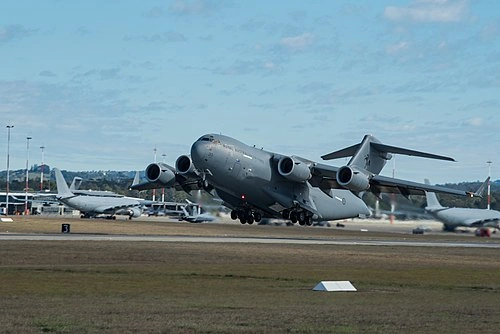Hundreds of brand-new Chinese-made cars sitting in a temporary storage yard directly opposite Australia’s biggest air base have sparked urgent security warnings from defence analysts.
The vehicles were spotted at RAAF Base Amberley, southwest of Brisbane, where over 5,000 defence personnel work. Security experts say the location raises serious questions about surveillance capabilities built into modern connected vehicles.
Cars Parked at Base Entrance Raise Eyebrows
Images show rows of Chery and Omoda Jaecoo vehicles parked in a makeshift compound right across from the main entrance and pass office at RAAF Base Amberley. The cars sit unwrapped in factory plastic, awaiting delivery to Australian dealerships.
The Department of Defence confirmed it knows about the stockpile. A spokesperson told media the vehicles are on private land adjacent to the facility.
This isn’t the first time Chinese cars have appeared in unusual locations around Australia. About 1,600 BYD vehicles were recently stored at Jamberoo Action Park south of Sydney without local council approval.

RAAF Base Amberley is Australia’s largest operational air base, employing over 5,000 personnel
Import Surge Creates Storage Problems
The influx of Chinese brands into Australia has created bottlenecks in the delivery process. New vehicles pile up at ports in capital cities before making their way to dealers across the country.
Temporary holding yards have sprung up in farmland, vacant blocks, airport precincts and now near military installations. The surge reflects China’s aggressive push into the Australian market as manufacturers chase ambitious 2035 electric vehicle targets.
Surveillance Concerns From Defence Experts
Michael Shoebridge from Strategic Analysis Australia and a former defence department official warned that Chinese-made cars present real risks Australia isn’t properly addressing.
He described modern electric vehicles as “software-defined systems – more like smartphones on wheels than old Falcons.” The constant connectivity gives Chinese intelligence agencies potential access to vast amounts of data.
“From an intelligence collection point of view, this creates great opportunities for Chinese security agencies to have periodic access to information collected about the car’s use,” Shoebridge said. He noted that every Chinese company must cooperate with Chinese intelligence services by law.
Built-in Surveillance Capabilities
Alastair MacGibbon from CyberCX highlighted the extensive sensor arrays in modern vehicles. He warned that connected-car functionality could be weaponised for “hybrid warfare” if the Chinese government chose to do so.
“They have cameras and LiDAR and microphones that essentially allow real-time observation of what’s around them. The manufacturer has access to all of those things,” MacGibbon told News.com.au.
The cars could potentially capture images of base operations, track personnel movements and monitor activity at Australia’s most important air force facility. RAAF Base Amberley hosts F/A-18F Super Hornets, F-35 Lightning II jets, KC-30A refuellers and C-17 Globemaster cargo aircraft.

Global Restrictions on Chinese Vehicles
Australia’s allies have already moved to restrict Chinese vehicles near sensitive sites.
The UK government introduced requirements this year that Chinese-made electric vehicles must be parked at least 3.2 kilometres away from sensitive areas. British authorities cited concerns that onboard sensors could collect intelligence data.
The United States has taken an even harder line. American authorities restrict Chinese-made vehicle movements around defence and government facilities. The US will ban Chinese software and hardware from connected vehicles starting in the 2027 model year.
China itself banned Tesla vehicles from military and government premises over similar surveillance concerns. Shoebridge pointed to this as proof that “Chinese agencies are aware of the opportunities” such technology presents.
Australia’s Critical Minerals Vulnerabilities
The security debate comes as Australia tries to reduce dependence on Chinese processing in critical minerals supply chains. China controls over 90% of rare earth processing globally despite Australia’s vast mineral resources.
Recent tensions have highlighted strategic vulnerabilities. Chinese warships near Sydney earlier this year drew heightened surveillance from Australian defence forces.
The US-Australia $3 billion minerals pact aims to diversify supply chains away from Chinese dominance. Defence analysts warn that technology dependence creates similar strategic risks.
Defence Response Remains Limited
The Defence Department’s acknowledgement of the situation appears to be the extent of official response so far. No restrictions have been announced on where importers can temporarily store Chinese vehicles.
The contrast with camera surveillance is stark. In 2023, the Australian government removed over 900 Chinese-made security cameras from federal facilities over security concerns. Defence Minister Richard Marles ordered audits to ensure all Hikvision and Dahua cameras were identified and removed.
Yet hundreds of vehicles with far more sophisticated sensors and connectivity now sit metres from Australia’s largest air base. The cars feature multiple cameras, GPS tracking, microphones and constant data transmission capabilities.
Also Read: DroneShield Withdraws $7.6 Million Order Announcement After Administrative Mix-Up
Questions About Supply Chain Security
The episode highlights broader questions about how Australia manages technology risks from Chinese manufacturers. Critics say the country lacks a comprehensive strategy to address surveillance threats from connected devices.
Australia’s ban on Chinese AI platform DeepSeek from government systems showed officials recognise data security risks. But enforcement remains patchy across different technology categories.
Security experts argue Australia needs clear guidelines for all connected devices that could collect sensitive information. The current ad-hoc approach leaves gaps that adversaries could exploit.
As Chinese manufacturers flood global markets with technologically advanced products, the challenge of balancing economic benefits against security risks will only intensify for Australia and its allies.












